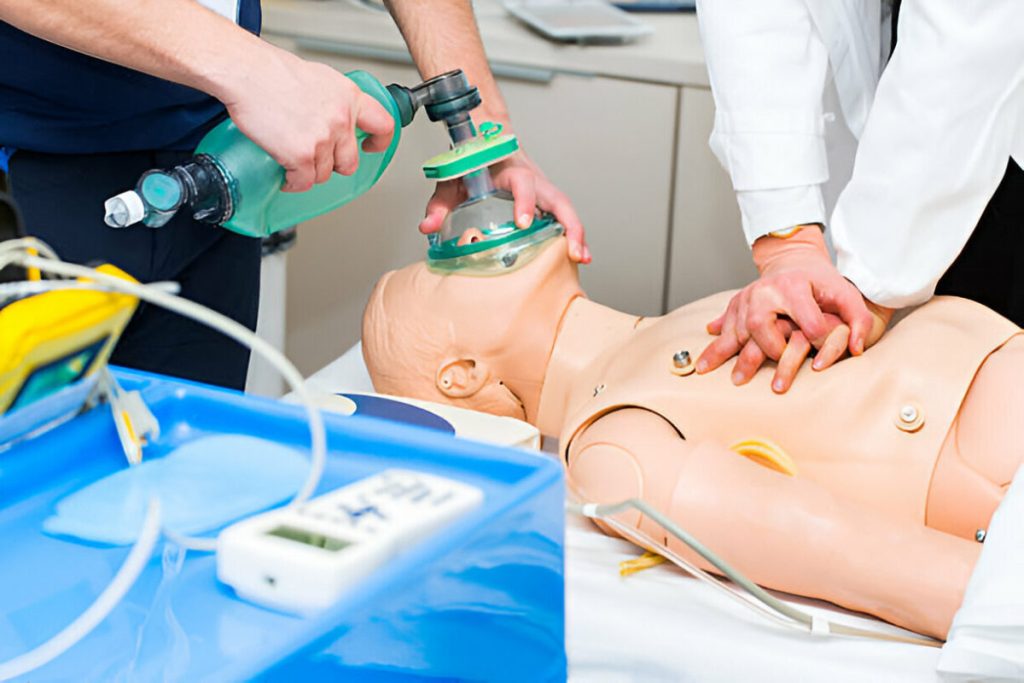In a cardiac emergency, immediate action can mean the difference between life and death. When someone’s heart stops beating, their survival chances decrease by 7-10% for every minute without cardiopulmonary resuscitation (CPR). Despite this stark reality, bystander CPR rates remain concerningly low across the United States. Only about 40% of out-of-hospital cardiac arrest victims receive CPR from bystanders before emergency medical services arrive.
The question becomes: Why do people hesitate when witnessing a cardiac emergency? Understanding these barriers is the first step toward creating solutions that empower more individuals to act confidently in crisis situations. This article explores the psychological, educational, and practical obstacles that prevent bystander intervention and offers evidence-based approaches to overcome them.
Common Barriers in Performing Bystander CPR
Fear of Causing Harm
One of the most prevalent concerns among potential rescuers is the fear of causing additional injury to the victim. Many bystanders worry they might break ribs, exacerbate existing medical conditions, or even cause death through improper technique. This fear often leads to paralysis in emergency situations, with bystanders choosing inaction over the possibility of making things worse.
Research indicates this fear is particularly pronounced among individuals without formal CPR training. Without knowledge of proper chest compression depth and technique, the physical aspects of CPR can seem intimidating and potentially dangerous. This perception creates a significant psychological barrier that prevents immediate action when seconds count.
Lack of Confidence in CPR Skills
Even individuals with prior CPR training frequently report a lack of confidence in their ability to perform the procedure correctly under pressure. Studies reveal that skill retention decreases significantly within just three to six months after initial CPR training, leading many to doubt their capability during an actual emergency.
This confidence gap is especially prevalent among those who received one-time training or training that lacked hands-on practice components. Without regular refreshers and practical application, many potential responders question whether they remember the correct sequence, proper hand placement, or appropriate compression rate—often leading to hesitation when faced with a real emergency.
Concern About Legal Liability
Legal concerns represent another significant barrier preventing bystander CPR. Many individuals fear potential lawsuits if their rescue attempt is unsuccessful or if the victim suffers complications. This worry persists despite Good Samaritan laws that protect rescuers acting in good faith across all 50 states.
The misunderstanding of these legal protections creates unnecessary hesitation during critical moments. Surveys indicate that up to 23% of respondents cite legal liability as a primary reason they might not perform CPR on a stranger, highlighting how misconceptions about legal consequences can override the impulse to help.
Fear of Disease Transmission
Health concerns, particularly regarding disease transmission through mouth-to-mouth contact, represent another significant barrier to performing CPR. Research shows that up to 30% of respondents in CPR attitude surveys express worry about contracting infectious diseases through rescue breathing.
This barrier has become especially pronounced following the COVID-19 pandemic, with heightened awareness of respiratory transmission increasing reluctance to make direct contact with strangers. Many potential rescuers remain unaware that current guidelines for lay rescuers emphasize hands-only CPR, which eliminates the need for mouth-to-mouth contact while still providing life-saving assistance.
Difficulty Recognizing Cardiac Arrest
Identifying a cardiac emergency presents a challenge for many bystanders. Unlike the dramatic portrayal in media, cardiac arrest often presents subtly, with victims showing minimal movement, gasping breaths that can be misinterpreted as normal breathing, or symptoms that might be confused with other conditions like seizures or intoxication.
This recognition gap leads to critical delays in initiating CPR. Studies show the average bystander takes approximately 2-3 minutes to recognize cardiac arrest and call emergency services—precious time that significantly reduces survival chances before intervention begins.
Barriers in Performing Bystander CPR: Demographic and Environmental Factors
Socioeconomic and Geographic Disparities
Research has consistently demonstrated that bystander CPR rates vary significantly across different communities. Neighborhoods with lower socioeconomic status experience bystander CPR rates up to 50% lower than more affluent areas. This disparity reflects reduced access to CPR training, fewer resources for community health education, and, in some cases, lower emergency response awareness.
Rural communities face additional challenges, with greater distances to emergency medical services and fewer opportunities for CPR training. These geographic barriers compound the existing hesitations around performing CPR, creating environments where immediate intervention is both more crucial and less common.
Cultural and Language Barriers
Cultural factors significantly influence the willingness to perform CPR. In some communities, touching strangers, particularly of the opposite gender, carries strong social taboos that conflict with the physical requirements of CPR. Additionally, emergency response systems primarily operate in English, creating communication barriers for non-English speakers attempting to receive dispatch-assisted CPR instructions.
These cultural and linguistic challenges create environments where bystanders may recognize an emergency but hesitate due to social norms or communication difficulties. Understanding these nuanced barriers is essential for developing inclusive approaches to emergency response education.
Overcoming Barriers: Solutions That Work
Simplified CPR Protocols for Lay Rescuers
One of the most effective strategies for increasing bystander intervention has been the development and promotion of hands-only CPR. By eliminating rescue breaths and focusing solely on chest compressions, this simplified approach addresses multiple barriers simultaneously: it reduces fear of disease transmission, simplifies the procedure for those with limited training, and makes the intervention less intimidating for first-time rescuers.
Research supports this streamlined approach, with studies showing that hands-only CPR can be as effective as conventional CPR for adult victims of witnessed cardiac arrest. The American Heart Association’s emphasis on “push hard and fast in the center of the chest” has transformed a complex medical procedure into an accessible action that average citizens can remember and implement.
Innovative Training Approaches
Traditional CPR training often involves scheduled classes lasting several hours, creating accessibility barriers for many individuals. Modern approaches have evolved to address these limitations through:
- Brief video training sessions (as short as 60 seconds) that teach essential compression techniques
- Mobile applications providing just-in-time instruction during emergencies
- Self-directed learning kits allow practice at convenient times
- Virtual reality simulations create realistic emergency scenarios
These innovative approaches significantly increase training accessibility while research demonstrates they can be remarkably effective. One study found that individuals who completed a 30-minute self-directed training session performed CPR with quality comparable to those who attended traditional courses.
Dispatch-Assisted CPR Programs
Emergency dispatchers now play a crucial role in guiding untrained bystanders through CPR. These programs train dispatchers to recognize cardiac arrest through telephone assessment and provide clear, step-by-step instructions to callers until emergency services arrive.
This real-time guidance addresses multiple barriers simultaneously: it reduces the need for prior training, builds confidence through professional direction, and provides reassurance regarding legal protections. Communities implementing dispatch-assisted CPR programs have seen bystander CPR rates increase by up to 40%, with corresponding improvements in survival outcomes.
Public Access Defibrillation Programs
Automatic External Defibrillators (AEDs) represent a critical complement to bystander CPR. These devices analyze heart rhythm and deliver electric shocks when necessary, addressing conditions that compression alone cannot correct. Modern AEDs are designed for public use, with voice instructions and simple interfaces that guide users through the process.
Expanding access to these devices in schools, workplaces, transportation hubs, and recreational facilities creates more comprehensive emergency response systems. When combined with CPR, early defibrillation can increase survival rates by more than 50% compared to CPR alone.
Community-Based Education Initiatives
Effective CPR education requires approaches tailored to specific community needs. Successful programs often incorporate:
- Training delivered in multiple languages reflecting community demographics
- Cultural adaptation addressing specific concerns and norms
- Implementation in trusted community spaces like places of worship and community centers
- Peer-to-peer education models where community members become instructors
These community-centered approaches build trust while addressing the specific barriers most relevant to local populations. Programs employing these strategies have demonstrated significantly higher training participation and subsequent bystander intervention rates.
Building a Culture of Readiness
Creating lasting change requires a shift from viewing CPR as specialized medical knowledge to considering it a fundamental civic skill. This cultural transformation involves:
- Implementing CPR training in school curriculums, ensuring all graduates possess basic lifesaving skills
- Workplace certification programs that normalize emergency response capabilities
- Public awareness campaigns highlighting successful bystander interventions
- Recognition programs celebrate civilian responders who take action during emergencies
These systemic approaches gradually reduce the psychological and social barriers to performing CPR by establishing intervention as an expected community responsibility rather than an exceptional act.
Call to Action
Preparing yourself to act confidently during a cardiac emergency doesn’t require medical expertise—just proper training and a willingness to help. CPR Louisville offers comprehensive, stress-free training programs that can equip you with the skills and confidence to respond effectively in crisis situations.
Whether you’re seeking personal preparation or professional certification, their American Heart Association courses provide the knowledge you need in a supportive, hands-on environment. Their offerings include:
- BLS certification in Louisville for healthcare professionals
- CPR certification in Louisville for individuals, families, and community groups
- First Aid training with practical, real-world applications
- ACLS and PALS certifications for advanced providers
Don’t wait for an emergency to wish you were prepared. Contact CPR Louisville today to schedule your training session and join the community of individuals ready to make a difference when seconds count. Best CPR training in Louisville is just a phone call away—because everyone deserves a prepared responder in their moment of need.
Conclusion
The barriers preventing bystander CPR intervention are complex and multifaceted, ranging from psychological fears to practical knowledge gaps. However, each obstacle has proven responsive to targeted solutions that simplify procedures, increase accessibility, and build community support systems.
By understanding these barriers and implementing evidence-based approaches to overcome them, we can significantly increase the likelihood that cardiac arrest victims receive immediate assistance. This transformation requires commitment from emergency response systems, educational institutions, community organizations, and individuals willing to prepare themselves for moments of crisis.
The potential impact is profound: for every 10% increase in bystander CPR rates, approximately 1,500 additional lives could be saved annually in the United States alone. Through continued innovation, education, and community engagement, we can build a society where bystanders become the critical first link in the chain of survival, turning moments of hesitation into decisive action that preserves lives.





